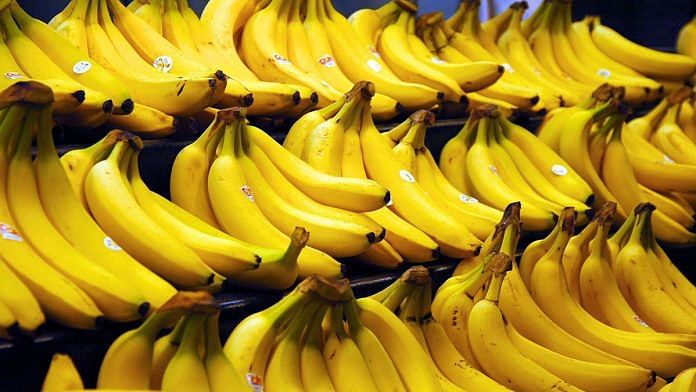- Bananas provide jobs and nutrition for more than 400 million people globally.
- But a quarter of the industry is threatened by a banana disease called fusarium, or Panama wilt.
- Using technologies related to nuclear technology, scientists are helping to breed disease-resistant bananas in Latin America.
Bananas provide jobs and nutrition for more than 400 million people globally. But the fruit is under threat from one of the world’s most devastating banana diseases.
Fusarium, or Panama wilt, is a type of fungus that is carried in the soil and attacks plants – and it has now taken hold in Latin America, having already devastated banana crops elsewhere in the world.
Of the 155 million metric tons of bananas produced every year, a quarter is threatened by fusarium wilt, according to the International Atomic Energy Agency (IAEA).
Nuclear rescue for bananas
Now the IAEA is helping scientists from six Latin American countries detect and contain the disease – using nuclear and related techniques.
Irradiation – exposing an object to radiation – is widely used in the food industry to safely destroy disease-causing bacteria and control pests without significantly affecting the food’s taste or smell.
To fight the banana disease, irradiation techniques are being used to help develop new disease-resistant crop varieties for farmers, in a process called mutation breeding.
In February, the IAEA trained 12 scientists from Brazil, Colombia, Costa Rica, Ecuador, Peru and Venezuela in mutation breeding. The training also covered tissue culture, developing mutant populations and how to screen crops for disease resistance.
Breeding new bananas
The latest variant of the fusarium wilt disease, called Tropical Race 4 (TR4), can “survive for decades in the soil, making it difficult to control,” the IAEA says. The focus on mutation breeding reflects that developing and deploying “new banana varieties with effective disease resistance” is the only long-term response to the disease.
The IAEA will be supporting the affected countries over the next five years in disease detection, surveillance, and containment with the help of nuclear and related technologies.
One of the most devastating banana diseases in the world – Fusarium – is spreading rapidly in Latin America. See how, with @FAO, we are using nuclear techniques to protect banana crops from this deadly fungus: https://t.co/hXNRUg2oZP pic.twitter.com/6mwgs2biem
— IAEA – International Atomic Energy Agency (@iaeaorg) April 7, 2022
Disease devastation
About 25 million tonnes of bananas a year are exported from tropical countries in Latin America, the Caribbean and other parts of the world.
The TR4 variant of fusarium was confined to Southeast Asia for decades, but was first discovered in Latin America in 2019, the IAEA explains. This caused a national emergency in Colombia, which is the world’s fifth biggest exporter of bananas.
In 2014, the United Nations Food and Agriculture Organization (FAO) and its partners said $47 million was needed to tackle the TR4 strain of fusarium wilt disease after it devastated banana crops in parts of Asia.
Indonesia had to stop banana exports of more than 100,000 tonnes a year, which led to annual losses of some $134 million alone on Sumatra, Indonesia’s third biggest island.
At the time, 40,000 hectares of banana crops in China and more than 6,000 hectares in the Philippines were affected by the disease.
Bananas are a vital crop
Bananas are the world’s most consumed and exported fruit and producing them is an industry worth $8 billion per year, the FAO says. For smallholder farmers, banana farming can account for up to 75% of monthly household income. In some developing countries, especially in rural areas, bananas can also provide up to a quarter of the daily calorie intake.
To improve food security and sustainable agriculture globally, the IAEA and FAO run a joint centre to advance and support the safe use of nuclear and related techniques and technologies in food and agriculture. The partners have worked on banana research and support for more than 20 years. The FAO is a specialist UN agency which works to eliminate hunger, food insecurity and malnutrition.
The power of nuclear technologies
The IAEA is an international organization that promotes the safe and peaceful use of nuclear technologies. Its programmes include NUTEC Plastics, a project to help tackle plastic pollution by using irradiation to recycle plastic waste into reusable resources. Monitoring marine environments for plastic pollution using a nuclear technique called isotopic tracing is another part of this programme.
The IAEA is also working with the World Health Organization to strengthen radiation treatment for cancer, a disease which killed 10 million people in 2020, and through the Zoonotic Disease Integrated Action (ZODIAC) initiative, is helping countries prevent pandemics caused by bacteria, parasites, fungi or viruses that originate in animals and can be transmitted to humans.
The article previously appeared in World Economic Forum.
Also read: Not just sugar and lack of exercise, but salt and dehydration are behind obesity epidemic



